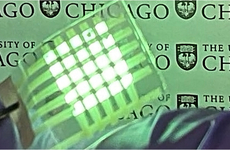
These Ultra-Thin Smartphone Touchscreens are Next-Generation
Michael Hemsworth — January 29, 2020 — Tech
References: rmit.edu.au & newatlas
A new electronic material with a touch-responsive design has been developed by a team of scientists in Australia as a potential innovation for creating smartphone touchscreens unlike ever before. The screens are characterized by their ultra-thin design that could one day be printed in a similar fashion to newspaper and manufactured on a large scale.
The material was developed by a team of researchers at RMIT University who took indium-tin oxide which is commonly found in smartphone touchscreens as the jumping off point for a malleable alternative.
Lead researcher Dr. Torben Daeneke spoke on the new material saying, "We’ve taken an old material and transformed it from the inside to create a new version that’s supremely thin and flexible. You can bend it, you can twist it, and you could make it far more cheaply and efficiently than the slow and expensive way that we currently manufacture touchscreens."
Image Credit: RMIT
The material was developed by a team of researchers at RMIT University who took indium-tin oxide which is commonly found in smartphone touchscreens as the jumping off point for a malleable alternative.
Lead researcher Dr. Torben Daeneke spoke on the new material saying, "We’ve taken an old material and transformed it from the inside to create a new version that’s supremely thin and flexible. You can bend it, you can twist it, and you could make it far more cheaply and efficiently than the slow and expensive way that we currently manufacture touchscreens."
Image Credit: RMIT
Trend Themes
1. Printable Touch-responsive Materials - Creating ultra-thin, touch-responsive materials could revolutionize the way touchscreens are produced and used.
2. Flexible Electronics Design - Developing new design approaches to create flexible electronic materials with improved performance characteristics would offer new design options in various industries.
3. Sustainable Electronic Manufacturing - Introducing cheaper and efficient ways of manufacturing electronic materials like touchscreens will bring about sustainable and cost-effective solutions for electronic devices.
Industry Implications
1. Electronics - The electronics industry could use this advancement to design and produce more innovative and cost-effective electronic devices.
2. Manufacturing - The manufacturing sector stands to gain from the introduction of more efficient and sustainable ways of producing electronic devices.
3. Telecommunications - Telecommunications companies could benefit from producing their own affordable and flexible touch-responsive materials for their electronic devices.
5
Score
Popularity
Activity
Freshness























